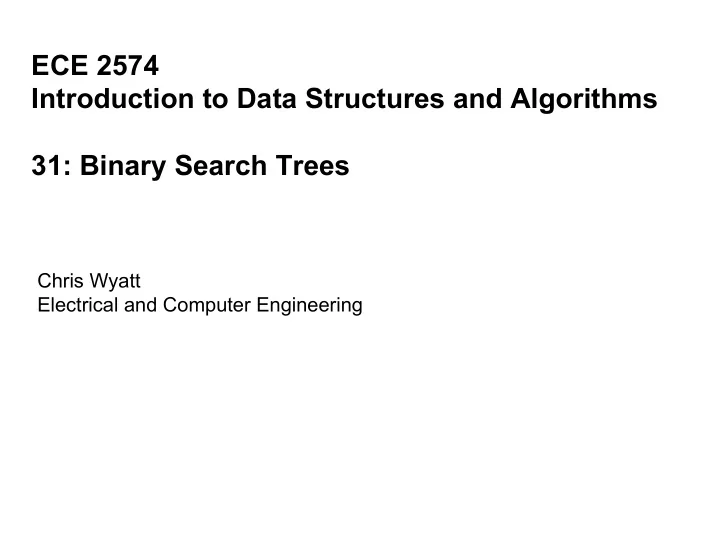

ECE 2574 Introduction to Data Structures and Algorithms 31: Binary Search Trees Chris Wyatt Electrical and Computer Engineering
Recall the binary search algorithm using a sorted list.
We can represent the sorted list using a binary tree with a specific relationship among the nodes.
This leads to the Binary Search Tree ADT. We can map the sorted list operations onto the binary search tree. Because the insert and delete can use the binary structure, they are more efficient. Better than binary search on a pointer-based (linked) list.
Binary Search Tree (BST) Operations Consider the items of type TreeItemType to have an associated key of keyType. // create an empty BST +createBST() // destroy a BST +destroyBST() // check if a BST is empty +isEmpty(): bool
Binary Search Tree (BST) Operations // insert newItem into the BST based on its // key value, fails if key exists or node // cannot be created +insert(in newItem:TreeItemType): bool // delete item with searchKey from the BST // fails if no such key exists +delete(in searchKey:KeyItemType): bool // get item corresponding to searchKey from // the BST, fails if no such key exists +retrieve(in searchKey:KeyItemType, out treeItem:TreeItemType): bool
Binary Search Tree (BST) Operations // call function visit passing each node data //as the argument, using a preorder //traversal +preorderTraverse(in visit:FunctionType) // call function visit passing each node data // as the argument, using an inorder //traversal +inorderTraverse(in visit:FunctionType) // call function visit passing each node dat a // as the argument, using a postorder // traversal +postorderTraverse(in visit:FunctionType)
An interface for Binary Search Trees Template over the key type and the value type. See abstract_bst.h
Binary Search Tree implementation. // get item corresponding to searchKey from the BST // fails if no such key exists +retrieve(in searchKey:KeyItemType, out treeItem:TreeItemType): bool
Pseudo-code for search // searches the BST tree for item corresponding to key search(intree:BinarySearchTree, in key:KeyItemType) if( tree.isEmpty() ) no item found if(key= key of the root) item found else if (key < key of the root) search(leftsubtreeof tree, key) else search(rightsubtreeof tree, key)
In class exercise What is the complexity of search?
How to insert into the BST so as to maintain the ordering. What if we try to search for key = 7 Search terminates at the right subtree of node 4. What does that mean ? If we insert 7 at ?, it is where it “ belongs ”
Pseudo-code for insert insert(in key:KeyItemType, in item:TreeItemType) if( search for key fails) if(key< last node searched) insert at left subtree of last node searched else insert at right subtree of last node searched endif else insert fails endif
In class exercise What is the complexity of insert?
How to delete from the BST so as to maintain the ordering. What if we try to delete key = 4? What if we try to delete key = 1? What if we try to delete key = 10? What if we try to delete key = 8?
Case where the node to delete has 2 children. Attempt to delete node 8. What if we find a node easier to delete and delete it instead. If we choose the inorder successor, we can copy its contents (key and item) into current node (8), then delete it instead.
The inorder successor of a node rooted at R, is the leftmost node of the right subtree of R. Which is the inorder successor of this subtree?
Pseudo-code for delete delete(in key:KeyItemType) if( search for key fails) delete fails else if (found node is leaf) delete it if (found node has left/right child only) delete node, replace with left/right child, else find inorder successor, copy to found node delete inorder successor endif endif
In class exercise What is the complexity of delete?
Next Actions and Reminders Read CH pp. 455-458 and Chapter 17 on heaps. Program 4 is due 11/17.
Recommend
More recommend